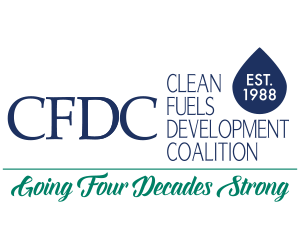PRESS RELEASE
CFDC Calls Nebraska E30 Demonstration One More Step Towards Higher Blends
Washington, D.C., March 8, 2021: The Clean Fuels Development Coalition (CFDC) today applauded the work of the State of Nebraska following the release of a report that found higher ethanol blends are safe, efficient, and cost effective when used in conventional vehicles.
The yearlong demonstration involved 50 non-flex fuel vehicles (non-FFVs) from the State of Nebraska’s fleet “to determine adaptability, economic feasibility, and environmental impact of using E30”. According to Nebraska Governor Pete Ricketts, the final report on the test indicates positive results on all counts.
“The research partnership between the State and the University clearly demonstrates that E30 is a safe and reliable fuel for vehicles,” said Governor Ricketts. “Ethanol saves drivers money at the pump, is good for air quality, and creates opportunities for our farm families. This study will be a great aid as we advocate for growing the volume of E30 in our nation’s fuel supply. In turn, raising demand for E30 biofuel will benefit Nebraska’s corn growers who supply 35% of their crop to our state’s ethanol industry.”
“These results validate what we have known for some time now, which is that today’s automobiles can perform quite well on higher ethanol blends, at a lower cost per mile and with significant environmental improvements”, said CFDC Member Jim Seurer of Glacial Lakes Energy in Watertown, South Dakota.
According to Seurer, who has sponsored the “E30 Challenge” for several years now, the Nebraska Report is consistent with the results of his ongoing demonstration program, which includes logging vehicles for mileage, emission, and performance issues.
Other studies from The Department of Energy’s Oak Ridge and National Renewable Laboratories have consistently shown improvements in emissions with no material degradation from higher blends.
The Nebraska report showed no mechanical issues when comparing E15 to E30 while showing a 40% reduction in CO2 emissions. Furthermore, assuming ethanol’s historical cost advantage over gasoline, the E30 blend would be the economic choice. Seurer noted that with recent reports indicating oil prices will continue to climb, providing consumers with a cleaner, lower cost fuel could not come at a better time.
With such a national priority on reducing carbon emissions, the CO2 reductions are significant. In Nebraska alone, if just 10% of the registered vehicles in the state were to use E30 it would result in a reduction of 64,000 tons per year of CO2 while providing a huge boost to the state’s ethanol industry.
Seurer pointed out several regulatory obstacles that need to be overcome for E30 to make a meaningful impact in the market. When Governor Ricketts made the initial request to EPA for approval of the test protocols, according to Seurer, he noted that EPA’s limitation on ethanol volumes were based on an outdated interpretation of the “substantially similar” rule on fuel additives that is no longer relevant since E10 is in the nation’s base fuel. By extension, the limit of the existing vapor pressure rule should apply to all blends above E10, not just E15. In fact, said Seurer, E30 reduces vapor pressure to the point where an rvp waiver is not necessary.
“We applaud Governor Ricketts, the University of Nebraska, THE Ethanol Board, and everyone who helped put this test and demonstration together, said Seurer. This is one more step toward widespread adoption of higher blends like E30”. A copy of the report can be found here.
CFDC Member David Hallberg of Dakota Ag Energy, a former Nebraska Ethanol Board Member, wrote Ricketts on behalf of the organization commending them for their work and providing a detailed background on the legal, scientific, and economic support for E30 fuels. Click here for a copy of the letter.
For more information contact:
Doug Durante, Executive Director, CFDC
cfdcinc@aol.com
www.cleanfuelsdc.org
